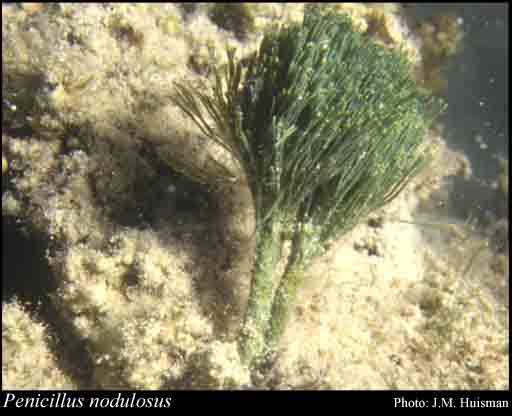- Reference
- Dict.Sci.Nat. [F. Cuvier] 60:516 (1830)
- Conservation Code
- Not threatened
- Naturalised Status
- Native to Western Australia
- Name Status
- Current

Scientific Description
Habit and structure. Thallus to 6–7 cm in height, gray green, heavily calcified, anchored by a large particle-binding holdfast 2–4 cm long, with a terete stipe topped by a capitulum of dichotomously divided siphons. Stipe 1–3 cm long, 1–8 mm in diameter, composed of siphons 180–200 µm in diameter bearing much-branched cervicorn lateral branches that form a solid cortex; capitulum hemispherical, generally 2–5 cm in diameter and composed of filaments 180–300 µm in diameter, these dichotomously divided and divaricate, typically with deep and shallow constrictions forming short moniliform segments. Filaments lightly calcified externally, the calcification regularly perforated with small round to oval holes 10–30 µm wide.
Reproduction. Not observed.
Distribution. Western, northern and eastern Australia, in warm waters; Indonesia. In W. Aust., recorded from Rottnest I. in the south to the Dampier Archipelago, but most likely occurring further north.
Habitat. Plants grow in sand, generally in shallow water and are often locally common.
Distribution
- IBRA Regions
- Carnarvon, Pilbara, Swan Coastal Plain, Yalgoo.
- IBRA Subregions
- Cape Range, Edel, Perth, Roebourne, Wooramel.
- IMCRA Regions
- Abrolhos Islands, Central West Coast, Ningaloo, Pilbara (nearshore), Pilbara (offshore), Shark Bay.
- Local Government Areas (LGAs)
- Ashburton, Carnarvon, Coorow, Dandaragan, Exmouth, Greater Geraldton, Irwin, Karratha, Rockingham, Shark Bay.